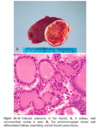[PATH} Thyroid Pathology Flashcards
(117 cards)
How do patients with thyroid storm typically present; if left untreated what is a common cause of death?
- Febrile and present w/ tachycardia out of proportion to the fever
- Death due to cardiac arrhythmias

What is the MOA of the antithyroid agent, propylthiouracil?
- Inhibits the oxidation of iodide and thus blocks production of thyroid hormone
- Also inhibits the peripheral deiodination of circulating T4 into T3
How does large doses of iodide given to an individual act as a goitrogen?
Blocks release of thyroid hormones by inhibiting the proteolysis of thyroglobulin
Inborn errors of thyroid metabolism causing congenital hypothyroidism is known as what?
Dyshormonogenetic goiter
What is the most common cause of hypothyroidism in iodine-sufficient areas of the world?
Autoimmune hypothyroidism i.e., Hashimoto thyroiditis
Which circulating autoantibodies are seen in association with Hashimoto Thyroiditis?
- anti-thyroid peroxidase (TPO)
- anti-thyroglobulin

What are the clinical features of Cretinism?
- Mental retardation
- Short stature
- Coarse facial features
- Protruding tongue
- Umbilical hernia

What are 2 possible causes of Cretinism?
- Areas w/o iodine supplementation
- Result of genetic alterations in normal thyroid metabolic pathways i.e., dyshormonogenetic goiter

The term Myxedema is applied to what situation?
Hypothyroidism developing in older children or adults
Histologically there is an accumulation of what in Myxedema; leads to what clinical findings?
- Matrix substances, such as glycosaminoglycans and hyaluronic acid in skin, subcutaneous tissue, and some visceral sites
- Leads to nonpitting edema, a broadening and coarsening of facial features, enlarged tongue, and deepening of the voice

Measurement of what in the serum is the best screeing test for both hyper- and hypothyroidism?
Serum TSH
What will levels of TSH be like in pt with primary hypothyroidism and primary hyperthyroidism?
- Primary hypothyroidism = ↑↑↑ TSH
- Primary hyperthyroidism = ↓↓↓ TSH
What is a major cause of nonendemic goiter in the pediatric population?
Hashimoto Thyroiditis
Polymorphisms in which immune-regulation associated genes are implicated in Hashimoto Thyroiditis?
CTLA4 and PTPN22
In Hashimoto Thyroiditis there is diffuse enlargement of the thyroid which is (painful or painless)?
Painless

In Hashimoto Thyroiditis there is extensive infiltration of the parenchyma by what cells and also the development of well-developed what?
- Mononuclear inflammatory infiltrate
- Well-developed germinal centers

What characteristic cell type is seen as part of the metaplastic response to injury in Hashimoto Thyroiditis?
Hurthle cells = atrophic follicle cells w/ eosinophilic change + granular cytoplasm

The presence of what in fine-needle aspiration biopsy samples is characteristic of Hashimoto Thyroiditis?
Hurthle cells + heterogenous population of lymphocytes

How does the fibrosis seen in Hashimoto’s differ from Reidel Thyroiditis?
In Hashimoto’s the fibrosis does NOT extend beyond the capsule of the gland
In the case of Hashitoxicosis what is seen with levels of free T3 and T4, TSH, and radioactive iodine uptake?
- T3 and T4 levels are elevated
- TSH is diminshed
- Radioactive iodine uptake is decreased
Patients with Hashimoto Thyroiditis are at an increased risk of developing what malignancy within the thyroid gland?
Extranodal marginal zone B-cell lymphoma
Although similar in presentation to Hashimoto’s what morphological features are not as prominent in Subacute Lymphocytic Thyroiditis?
Fibrosis and Hurthle cell metaplasia are NOT prominent
Granulomatous Thyroiditis (De Quervain) is thought to be triggered by what?
Viral infection (i.e., hx of URI just before onset of sx’s)
What histological findings are associated with Subacute thyroiditis (de Quervain)?
- Granulomatous inflammation w/ multinucleate giant cells
- Initially has more neutrophilic infiltrate w/ microabscess formation; then replaced by a more generalized inflammatory infiltrate with macrophages and multinucleated giant cells










































